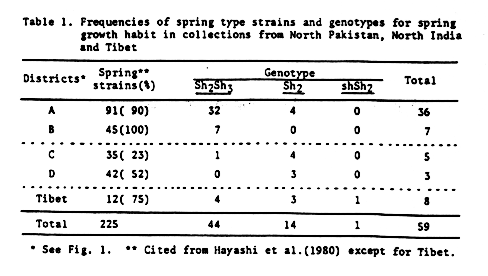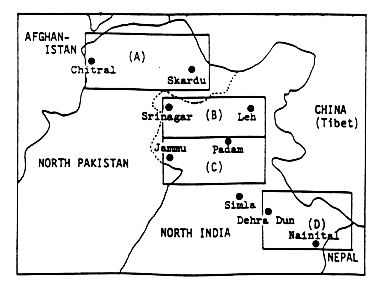

Paper by Yasuda, et al in BGN 16: 18-19.
A portion of this paper was inadvertently omitted
when printed. The entire paper is herinafter
printed:Genotypic differentiation in spring growth habit
barley strains collected from northern parts of
Pakistan and India, and Tibet. S. Yasuda, J.
Hayashi and I. Moriya. Institute for Agricultural
and Biological Sciences, Okayama University,
Kurashiki 710, Japan.
Hayashi et al. (1980) investigated morphological and physiological features of more than 200 strains which were collected by Dr. J. R. Witcombe in 1974 from four districts (named A, B, C and D in this paper) of northern Pakistan and India (Fig. 1). According to them, 90-100% of the strains in A and B districts and 20-50% of the strains in C and D districts were of spring growth habit (Table 1). A further study was made of the genotype constitutions for spring growth habit using the Witcombe collections, together with Tibetan strains collected by Dr. H. Smith (1935).

F2 hybrids from crosses between spring strains of the collections and some certain winter cultivars with known genotype and their F3 strains were grown under 24 hr illumination in a greenhouse, and investigated for segregation of spring and winter type plants, 15:1 and 3:1, were found among F2 populations. An identification test for the spring genes involved indicated that spring type strains of Witcombe's collections were of either two dominant genotype, Sh2Sh3, or one dominant genotype, Sh2(Table 1). Spring strains from A and B districts were mainly of Sh2Sh3 genotype, while those from C and D districts were mostly Sh2 genotype. On the other hand, Tibetan spring barleys consisted of Sh2Sh3 and Sh2 genotype strains in almost the same frequency, with one exception of one recessive and one dominant genotype strain, shSh2
According to Our study hitherto made of spring varieties collected from various regions of the world, the Sh2Sh3 genotype occurs most frequently in North Pakistan, North India, Tibet and Ethiopia. Furthermore, according to collector's records, this genotype strains were collected in rather higher altitude than those of the Sh2 genotype. This may suggest that the Sh2Sh3 genotype strains are most adaptive to higher altitude than the Sh2 genotype ones.
